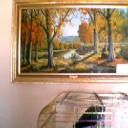Yahoo Answers is shutting down on May 4th, 2021 (Eastern Time) and beginning April 20th, 2021 (Eastern Time) the Yahoo Answers website will be in read-only mode. There will be no changes to other Yahoo properties or services, or your Yahoo account. You can find more information about the Yahoo Answers shutdown and how to download your data on this help page.
Trending News
How do you know where the descriptive word goes in the sentence? Is it a matter of preference?
I have someone editing my book for me and they keep re-arranging my sentences.
Like this:
She grabbed the shotgun with a wince. (mine)
Wincing, she grabbed the shotgun. (the edit)
And I was trying to figure this one out by myself. Doesn't it work either way?
Ann and Penny screamed and O'Neil hooted excitedly.
Ann and Penny screamed and O'Neil excitedly hooted.
Ok. Makes sense. But the sentence leading to her picking up the gun mentioned her broken rib. I guess I figured everyone would read it and correlate it with the pain from the broken rib. Cool. Thanks. Any other advice or tips is greatly appreciated.
I also, apparently, don't use commas appropriately. Poor lady is sticking em in everywhere.
5 Answers
- davidjohnston29Lv 74 years agoFavorite Answer
Yes, "winces" are not things you can use to grab things. As for the second one, personally I prefer not to end a sentence with an adjective as well, but it doesn't make much difference. I'd prefer "hooted with excitement" actually.
- Madame MLv 74 years ago
Practically speaking, you put the descriptive word as close as you can to what it is describing. Everyone knows that a shotgun doesn't wince, but people who have been trained to edit will wince at your sentence and imagine a wincing shotgun.
As for the second, the normal way to hoot is excitedly, I think, so you should cut the adverb. If it's a marked state (ie: not normal), then I think you can put the adverb in front or behind. English teachers would tell you that they go after the main verb, but I think there are rhythm and scanning problems (even in prose) that make it better for the adverbs to go elsewhere. If you don't care, and can't say why you put it in a certain place, then you'd better move it to after the main verb. It goes in front to emphasize . . . which means different things to different editors.
Commas are a bear, and if you plan to write, you might as well take three or four weeks to check every single comma you've written and internalize the rules. For most American writers of fiction, you'll be following the Chicago Manual of Style. That means Oxford (serial) commas, and all those weird rules about when to use them and when not to use them when you are writing a series of adjectives that are alike (or not alike) in quality.
BTW, the Purdue OWL (Online Writing Lab) is a fabulous, free resource. Here's what they say about adjectives and adverbs: https://owl.english.purdue.edu/owl/resource/537/02...
- DianeLv 44 years ago
The way you have written the sentence it sounds as if the shotgun winced. That is not what you mean, I'm sure, so she is just rearranging your words for the sake of clarity. There's now particular rule about where the descriptive word goes, it just has to make sense.
- hillbillyLv 74 years ago
Trust the editor, the corrections are right. The way you put it, the shotgun was there with a wince on it. And, considering "hooted" to mean 'yelled', then "he yelled "excitedly". See the difference?
- How do you think about the answers? You can sign in to vote the answer.
- ?Lv 74 years ago
Yours could sound like she used a wince to pick it up.
She grabbed the shotgun with a glove.







